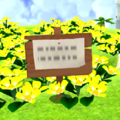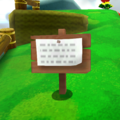User:Nintendo101/flowerpot: Difference between revisions
Nintendo101 (talk | contribs) m (→See also) |
Nintendo101 (talk | contribs) |
||
| Line 22: | Line 22: | ||
====''Super Mario Sunshine''==== | ====''Super Mario Sunshine''==== | ||
Only staked signs appear in ''[[Super Mario Sunshine]]''. The player can read one by pressing {{button|gcn|b}}. Signs do not present tips on actions or progression, instead relaying [[mission|episode]]-specific information about the active [[level|stage]]. The details written on some signs changes depending on the active episode, such as the one in front of the [[Surf Cabana]] on [[Gelato Beach]]. Unlike ''Super Mario 64'', signs have no secondary interactive component to them. In the original Japanese release, English text is displayed on signs. It is replaced with the [[Isle Delfino#Language|original language of Isle Delfino]] in the North American localization. | |||
====''Super Mario Galaxy''==== | ====''Super Mario Galaxy''==== | ||
Staked signs appear throughout ''[[Super Mario Galaxy]]'' and can be be read when the player presses {{button|wii|a}}. Like prior appearances, nearly all signs are inanimate objects that the player choses to engage with. However, a few [[Boards (characters)|speaking board character]]s impose themselves in scenarios where the player character's controls are different from usual. For example, the first one, Bill Board, appears in the [[Rolling Green Galaxy]] where [[Mario]] (or [[Luigi]]) can only traverse platforms on the [[Star Ball|Rolling Ball]]. | |||
As in ''Super Mario Sunshine'', signs lack secondary interactive elements, though one in the [[Ghostly Galaxy]] is written in [[Boo#Language|Booish]] and can only be read if the player character is in their [[Boo Mario|Boo form]]. | |||
====''Super Mario Galaxy 2''==== | ====''Super Mario Galaxy 2''==== | ||
Revision as of 22:46, April 27, 2024
| flowerpot | |
|---|---|
 Screenshot from Super Mario Odyssey | |
| First appearance | Super Mario 64 (1996) |
| Latest appearance | Super Mario Bros. Wonder (2023) |
| Effect | Provides information when read. |
- “To read a sign, stand in front of it and press B, like you did just now.”
- —Sign in the Bob-omb Battlefield, Super Mario 64
Travel Tips, also known as signs[1][2][3] or signboards,[4] are bulletins in the Super Mario franchise that debuted in Super Mario 64. In all appearances, a Travel Tip provides information on an available action or the current level when prompted. Travel Tips are either staked into the ground like posts or fastened to the side of walls. Staked Travel Tips often have a secondary interactive element. They are comparable to Message Blocks and, to a lesser extent, Professor Chops.
The player is rarely obligated to read Travel Tips. Rather, they are available at their discretion. In Super Mario Galaxy and Super Mario Galaxy 2, there are a few boards that are conscious, speaking characters that do impose themselves onto the player character when encountered.
History
Super Mario series
Super Mario 64 / Super Mario 64 DS

Signs can be read by the player character in Super Mario 64 and Super Mario 64 DS by pressing ![]() on the Nintendo 64 Controller or
on the Nintendo 64 Controller or ![]() on the Nintendo DS system, respectively. It is the same input used by the player to speak with a non-playable character. Signs compensate for the diversity of moves the developers included in the game.
on the Nintendo DS system, respectively. It is the same input used by the player to speak with a non-playable character. Signs compensate for the diversity of moves the developers included in the game.
Typically, signs provide information on a move the player can perform or contextualize a potentially cryptic detail in the environment. The signs that are staked into the ground can be ground-pounded by the player character, rendering it unreadable unless they exit and reenter the course. Like stakes, it takes Mario and most of the other playable characters in Super Mario 64 DS three strikes to fully bury the sign. It takes Wario only one. Signs otherwise occur pinned to walls.
Some of the text on signs were written by other characters in the game, such as the Big Bob-omb, a Big Penguin, and a Piranha Plant. Ukikipedia has fully documented all lines of text displayed on the signs and the locality of each one, which can be viewed here.
Super Mario Sunshine
Only staked signs appear in Super Mario Sunshine. The player can read one by pressing ![]() . Signs do not present tips on actions or progression, instead relaying episode-specific information about the active stage. The details written on some signs changes depending on the active episode, such as the one in front of the Surf Cabana on Gelato Beach. Unlike Super Mario 64, signs have no secondary interactive component to them. In the original Japanese release, English text is displayed on signs. It is replaced with the original language of Isle Delfino in the North American localization.
. Signs do not present tips on actions or progression, instead relaying episode-specific information about the active stage. The details written on some signs changes depending on the active episode, such as the one in front of the Surf Cabana on Gelato Beach. Unlike Super Mario 64, signs have no secondary interactive component to them. In the original Japanese release, English text is displayed on signs. It is replaced with the original language of Isle Delfino in the North American localization.
Super Mario Galaxy
Staked signs appear throughout Super Mario Galaxy and can be be read when the player presses ![]() . Like prior appearances, nearly all signs are inanimate objects that the player choses to engage with. However, a few speaking board characters impose themselves in scenarios where the player character's controls are different from usual. For example, the first one, Bill Board, appears in the Rolling Green Galaxy where Mario (or Luigi) can only traverse platforms on the Rolling Ball.
. Like prior appearances, nearly all signs are inanimate objects that the player choses to engage with. However, a few speaking board characters impose themselves in scenarios where the player character's controls are different from usual. For example, the first one, Bill Board, appears in the Rolling Green Galaxy where Mario (or Luigi) can only traverse platforms on the Rolling Ball.
As in Super Mario Sunshine, signs lack secondary interactive elements, though one in the Ghostly Galaxy is written in Booish and can only be read if the player character is in their Boo form.
Super Mario Galaxy 2
Nearly all of the signs in Super Mario Galaxy 2 are presented as inanimate objects. The only character from the previous game to return is Bill Board. However, there are a few instances where simply being near a sign causes a small dialogue box to appear above it, suggesting they can "call out" to the player character. While largely unchanged, signs have more lines of text on the page nailed to their exterior.
A green monitor displaying the Tip Network appears in a galaxy if the player has lost a certain number of lives, offering to demonstrate what the player needs to do in the active galaxy. Its dialogue suggests the Tip Network is a conscious character.
Super Mario Odyssey
Signs, under the name of Travel Tips, appear throughout Super Mario Odyssey. It is the first 3D game in the Super Mario series to include these signs in seven years. Most Travel Tips only inform the player an action available to Mario and/or Cappy. Environmental details are instead available in the visited kingdom's brochure, while hints on course progression are in the names of the objectives and can be relayed by Hint Toad, Talkatoo, and Uncle amiibo. However, the Travel Tip found by Yoshi's House was directly written by him. After a Travel Tip is read, an animation of the action being performed appears in the bottom right of the screen.
Unlike previous titles, Travel Tips are made of metal in Super Mario Odyssey. Like Arrow Signs, staked Travel Tips spin when struck by Cappy. They otherwise appear fastened to the sides of terrain.
Super Mario Bros. Wonder
Travel Tips appear in Super Mario Bros. Wonder, a 2D game that saw involvement from Nintendo EPD staff typically involved with the 3D ones.[5] This is their first appearance in a 2D Super Mario title. Travel Tips only appear in the overworld map of the Flower Kingdom and relay information about the overworld itself. As in Super Mario Odyssey, they are depicted here as metal. At least one Traveling Tip is posted in each world.
Paper Mario series
Paper Mario
called a "signboard" in the Close Call (badge) prediction. (If this thing just displays the map, then I don't think it belongs here.)
Paper Mario: The Thousand-Year Door
dunno
Super Paper Mario
dunno
Paper Mario: Sticker Star
dunno
Paper Mario: Color Splash
dunno
Paper Mario: The Origami King
dunno
Professor Toad also helps Mario decipher ancient texts which are otherwise illegible, found on signs and slabs throughout the Scorching Sandpaper Desert. A full documentation of his translations can be viewed here.
Mario & Luigi series
Mario & Luigi: Superstar Saga / Mario & Luigi: Superstar Saga + Bowser's Minions
dunno
Mario & Luigi: Partners in Time
dunno
Mario & Luigi: Bowser's Inside Story / Mario & Luigi: Bowser's Inside Story + Bowser Jr.'s Journey
dunno
Mario & Luigi: Dream Team
dunno
Mario & Luigi: Paper Jam
dunno
Gallery
Names in other languages
| Language | Name | Meaning |
|---|---|---|
| Japanese | Kanban |
Signboard |
| French | Affiche[10] |
Poster |
| Spanish | Signo[11] |
Sign |
See also
References
- ^ Nintendo of America (1996). Super Mario 64 Instruction Booklet (PDF). Redmond: Nintendo of America. Page 8.
- ^ Nintendo of America (2005). Super Mario 64 DS Instruction Booklet. Redmond: Nintendo of America. Page 13.
- ^ "While standing in front of certain characters or signs, you can press
 to speak or read." – Nintendo of America (2007). Super Mario Galaxy Instruction Booklet (PDF). Redmond: Nintendo of America. Page 13.
to speak or read." – Nintendo of America (2007). Super Mario Galaxy Instruction Booklet (PDF). Redmond: Nintendo of America. Page 13.
- ^ "Stand in front of certain characters and press the A Button to talk to them, or stand in front of signboards and press the A Button to read them." – Nintendo of Europe (2010). Super Mario Galaxy 2 Instruction Booklet (PDF). Großostheim: Nintendo of Europe. Page 18.
- ^ Nintendo (18 Oct. 2023). Super Mario Bros. Wonder—Part 3. Ask the Developer Vol. 11.
- ^ Nintendo Co., Ltd. (1997). 『Super Mario 64 振動パック対応バージョン
取扱説明書 』 (PDF). Tokyo: Nintendo Co., Ltd. (Japanese). Page 8. - ^ Nintendo Co., Ltd. (2004). 『Super Mario 64 DS
取扱説明書 』 (PDF). Tokyo: Nintendo Co., Ltd. (Japanese). Page 11. - ^ Nintendo Co., Ltd. (2007). 『Super Mario Galaxy
取扱説明書 』 (PDF). Tokyo: Nintendo Co., Ltd. (Japanese). Page 16. - ^ Nintendo Co., Ltd. (2010). 『Super Mario Galaxy 2
取扱説明書 』 (PDF). Tokyo: Nintendo Co., Ltd. (Japanese). Page 18. - ^ Nintendo of America (2007). Super Mario Galaxy Instruction Booklet (PDF). Redmond: Nintendo of America (French). Page 35.
- ^ Nintendo of America (2007). Super Mario Galaxy Instruction Booklet (PDF). Redmond: Nintendo of America (Spanish). Page 57.











